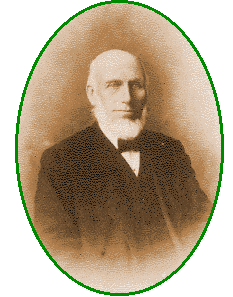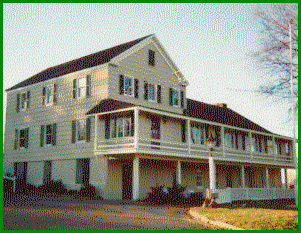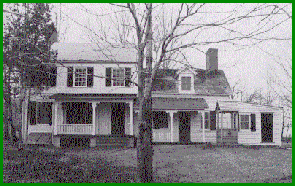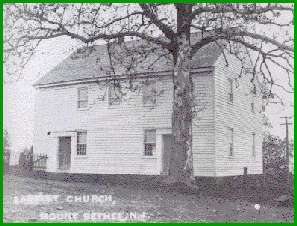|
 pastor from 1871 to 1911 preached nearly two thousand sermons during his years at Mount Bethel. Warren Township, by Alan A. Siegel, page 33 |
|
 pastor from 1871 to 1911 preached nearly two thousand sermons during his years at Mount Bethel. Warren Township, by Alan A. Siegel, page 33 |

|
Images of America - Warren Township by Alan A. Siegel - 1996 The Watchung Mountains, whose natural beauty characterizes the township, came into being 125 million years ago when volcanic eruptions to the west covered the area with two thick lava flows that later were tilted upwards 20 degrees. Then, gradually, imperceptibly, during the millions of years that followed this massive shifting of the earth, water eroded away the land, exposing the jutting edges of the buried lava. These exposed basaltic edges, now much weathered, are the First and Second Mountains; between them lies a broad, fertile valley through which flows the Middle Brook. The Lenape Indians roamed these parts for thousands of years before the Europeans came, but they left little history; a few arrowheads and grinding stones have been found along the Passaic River; Dock Watch Hollow is the only locale that bears an Indian name. English and Scots-Irish from Turkey (now New Providence) and Scotch Plains first settled the township in the 1720s. Farmers from New Providence Followed the Passaic River into what is now Union Village and Smalleytown. To the south, pioneers from the lowlands moved through Lincoln Gap (Somerset Street, Watchung) and into Washington Valley. Philip Cox may have arrived here as early as 1727, the year he bought 200 acres "betwixt the first and second mountain called the Blue Hills." Until 1743, when the Borders of Somerset County shifted northward, Warren was part of Elizabeth Borough in Essex County. By the time of the American Revolution, fewer than a hundred families lived in what would become Warren, eking out a living from the stone-scattered fields. There were saw and grain mills on Coryís Brook, in Dock Watch Hollow, and elsewhere. A Baptist Church on Old Church Road and a schoolhouse on Mount Bethel Road were the centers of community life. Twenty or so men from Warren served in the state militia. One of them, David Smalley, rose to the rank of captain.
Land values were low and the population static. Indeed, the population actually declined from 1,097 in 1875 to 1,083 in 1920. By 1933, when Warren finally sold its one-room schoolhouses after Central School opened, the population only reached 1,500. World War II had an enormous impact on the community. Almost all able bodied young men (and some women, too) served in the armed forces. The post-war demand for housing spurred a flurry of new construction - the number of homes increased 45 percent during the years 1946-48. New schools and paved roads inevitably followed, encouraging even more construction. A second building boom in the 1960s drove the population to 8,592 by 1970. A shopping center, the town hall, and a cluster of commercial buildings made Warrenville the new "downtown." To many old timers, it seemed that the township had been transformed beyond recognition. But when Route 78 finally opened to its full length in 1986, still another wave of building crested over the remaining farmland. In 1992 alone, the town approved nearly one thousand new homes. A luxury hotel that opened in 1989 and AT&Tís multimillion-dollar complex on King George Road (finished 1996) completed the transformation. Population now exceeds 12,000. As late as 1982 there were still 150 working farms on the township. Now most of them are but a memory, the victims of progress. Almost from the beginning, Warren was a scattering of small villages, often mere crossroads. Centered about a church or school, even in their heyday these villages boasted only a post office and general store, perhaps a blacksmith shop and a few houses. Their names - Mount Horeb, Coontown, Mount Bethel, Union Village, Smalleytown, Warrenville and Springdale - evoke pleasant memories still. While enough of the old-time Warren remains to hint at what once was, much has been lost during the last forty years. The photographs we present here preserve the past, offering a visual history that will stir the memories of longtime residents and encourage a sense of pride in those new to Warren Township. |

 MAP MAP

|
|

|
 MAP MAP

|

 MAP MAP

|
|


 Warren Township Local History
Warren Township Local History
 Susie Boyce Susie Boyce Springdale Methodist Church History
Springdale Methodist Church History
 Susie Boyce Susie Boyce
 Warren Township Map
Warren Township Map
 Warren Website - History Page
Warren Website - History Page
 Barbara Mellen Barbara Mellen National & NJ Historic Sites
National & NJ Historic Sites
 Somerset Cty. Cultural & Heritage Comm.
Somerset Cty. Cultural & Heritage Comm. |

|
Directory |
Calendar |
Town Map |
Township Committee |
Library |
Schools |
History |
|
Civic Organizations |
Community TV |
Recreation |
Emergency Information |
Voter Information |
Support Services |
This site is maintained by BDM
This page was last updated 7/8/98